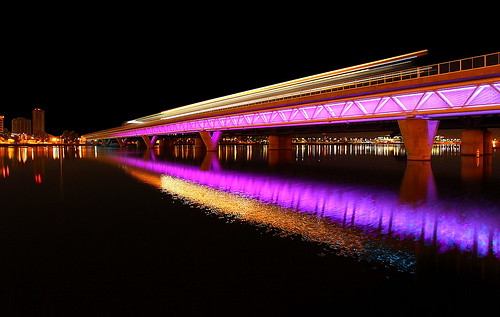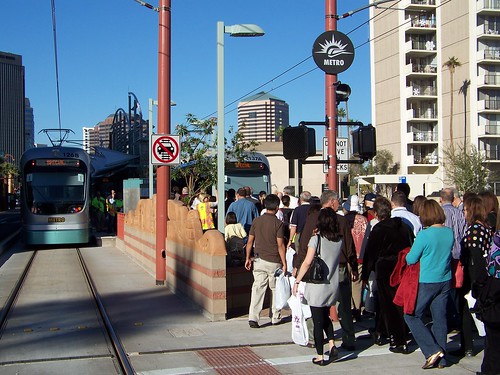Quote of the day: rail transit is antiquated, like delivering a bucket of ice to Congressional offices

Image: Mark Henle/The Arizona Republic, 2009.
Phoenix's local elections are underway and a transportation sales tax referendum is on the ballot.
In 2000, an increase in the sales tax was approved to help fund the then under construction light rail system. That tax remains authorized for five more years.
But there is a proposal to fold that tax into a broader transportation sales tax, which would also fund other transportation infrastructure.
With the new tax, the sales tax would be 8.6%, but unlike the current tax, which only funds light rail capital improvements, the new tax would also be used for operations--20% of the total for light rail capital improvements, 7% for light rail operations, and 73% for other infrastructure--mostly road improvements, but also investments in pedestrian, bicycle, and bus programs.
-- MovePhx, pro-Proposition 104 website
The Arizona Republic has a fair amount of coverage on the topic, and plenty of op-ed pieces for and against. But my favorite quote on the subject comes from Felix Garcia, candidate for City Council in District 5:
"During a recent visit to Washington, D.C., I learned from the elevator operator that, up until recently, Congress paid for daily ice delivery to its members and their staffs. Every morning before 9 a.m., employees would deliver 900 buckets of cubes to congressional offices. No one was quite sure how the practice got started, but it had been going on for years. The cost was estimated at $500,000 a year! Ice delivery is like rail. It’s costly and outdated. Technology develops too quickly to pin our transit hopes on rail. A 35-year tax will become a painful joke to the next generation.”The reality is that rail transit works fine in the 21st century to move people around. Just like ice is still a good way to make a beverage colder. It's all about how you go about getting it.
Of all the candidates interviewed for the AR article, only two, the Republican candidate for Mayor, Anna Brennan, and Mr. Garcia, are against the tax/light rail. Matt Jette, the independent candidate for Mayor, argues that the plan doesn't go far enough.
 The light rail bridge across the lake in Tempe incorporates architectural lighting and treats what could be ordinary and unattractive infrastructure as an element of civic architecture. Flickr photo by Grant Brummett Photography.
The light rail bridge across the lake in Tempe incorporates architectural lighting and treats what could be ordinary and unattractive infrastructure as an element of civic architecture. Flickr photo by Grant Brummett Photography.Phoenix is a lot bigger than Salt Lake City and Portland, but very much sprawled.
Heavy rail transit isn't an economically efficient option there, given the paucity of "density."
But places like SLC and Portland have demonstrated that in smaller places, light rail can be an effective and efficient method for shaping transportation and land use in optimal ways.
For a one line system--20 miles of track, 28 stations--Phoenix is doing pretty well with ridership, with 47,500 daily riders according to the latest transit ridership statistics.
That compares very well to Salt Lake, which has 65,000 daily riders but 45 miles of trackage and 69 stations over three lines, and Portland, 116,000 daily riders, over four lines, 52 miles of track and 87 stations.
The Phoenix numbers are better than Houston's--which has about the same amount of track and a few more stations, but on three lines--and triple that of Charlotte, NC.
According to some studies ("Valley Metro: Development along light rail tops $8 billion," Phoenix Business Journal), the Phoenix Light Rail system has fostered slightly more than $8 billion in new development, which is six times greater than the cost to build the system.
-- Light Rail Economic Impact Analysis Task 1 Final Report, ASU
-- The Businesses of Light Rail: A Compilation of Local Business Interviews, Arizona PIRG Education Fund (more a qualitative study about the experience of individual businesses located in areas served by the then new light rail system)
Given the strong anti-tax Republican tinge of Arizona more generally, it will be interesting to see what happens, although according to the Phoenix Business Journal ("Phoenix Proposition 104: Wrong side of the tracks or transit vision to contain sprawl?) it's likely to pass.
 Flickr photo by Nick Bastian.
Flickr photo by Nick Bastian.Like mayoral candidate Matt Jette, the piece points out problems with the proposed transit expansion, and how Scottsdale, one of the metropolitan area's leading destinations, isn't much committed to light rail connections.
We'll know after August 24th.
=====
With regard to the economic impact numbers, it's hard to be definitive.
There is no question some of the development would have occurred anyway. But the velocity of development is impacted by the existence of transit and the way location choices are reshaped by it is significant.
More importantly, what a lot of people fail to realize is how long it takes to begin to see impact. With the WMATA system, in many respects it took about 25 years to really begin to see significant impacts.
(Individual building projects can take a long time. One building on H Street NE, a couple blocks from Union Station, took about 13 years from the start of one process and the completion through a completely different project than was originally intended.)
Only now are stations outside of core sections of the system (Downtown DC, Wilson Boulevard in Arlington County, Bethesda, Silver Spring) starting to reap the benefits, although a goodly reason for this is the dissipation of build out opportunity in the core as well as a better understanding of how to do "transit oriented development" "properly."
By contrast, the Phoenix light rail system has been operating for seven years.
Labels: car culture and automobility, government organization, public finance and spending, sales tax revenues, transit infrastructure, transportation planning, voting and referendums



5 Comments:
An *elevator operator* commenting about ice bucket delivery being antiquated. That's kind of funny.
That Ice Delivery quote - it wasn't that it stopped 'recently,' that practice was ended in 1995!
Good points. Too bad the Arizona Republic staffers conducting the interviews didn't know those facts, or make the point about "elevator operators".
Thanks so much for the site, I found a lot of useful information for us.
Thanks for sharing this information and keep updating us. Really this information is more useful to me.
youcut video editor for pc
Post a Comment
<< Home